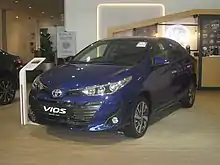Toyota Motor Thailand
Toyota Motor Thailand Co., Ltd. (TMT) is the wholly owned subsidiary of Toyota Motor Corporation in Thailand, established in 1962. In 1979, Toyota began making pressed body parts in Thailand. In 1989, TMT began manufacturing engines locally. TMT controls the manufacturing of Toyota cars in Thailand and they supply cars to various official dealers throughout Thailand. TMT's main export market is the ASEAN region and the Oceania, but TMT also export cars to different parts of the world, especially the Toyota Hilux Vigo model. As of April 2016, there were 150 official Toyota dealers with 455 showrooms approved by TMT.[1]
Native name | บริษัท โตโยต้า มอเตอร์ ประเทศไทย จำกัด |
|---|---|
| Type | Subsidiary |
| Industry | Automotive |
| Genre | Motor cars |
| Founded | 5 October 1962 |
| Headquarters | , |
Key people | Ninnart Chaithirapinyo (Chairman) Noriaki Yamashita (President) |
| Products | Automobiles, commercial vehicles, engines |
Production output | 760,000 vehicles (max.) |
| Owner | Toyota Motor Corporation (86.4%) |
| Website | www |
Operations
As of July 2016, TMT employed 16,477 at its Thai factories. Toyota Motor Thailand runs three plants in two provinces. The plant in Samrong, Samut Prakan Province produces pickup trucks and commercial vehicles. The two plants in Chachoengsao Province—at Ban Pho and Gateway—make passenger cars. The three plants have a combined maximum annual capacity of 760,000 units.[2]
Sales
Toyota posted its highest-ever Thai sales in 2012 at 516,086 vehicles, a 78 percent rise from 2011. Sales decreased by 13.7 percent to 445,464 in 2013 and shrank by 26.6 percent to 327,027 in 2014. In 2015, TMT reported sales of 266,005 vehicles, down 18.7 percent. Sales for the first five months of 2016 totalled 87,715 vehicles, down 13.4 percent from the same period in 2015. The company projected its 2016 whole-year sales to fall by 9.8 percent from 2015 to 240,000 vehicles, the fourth successive year of declining sales.[2]
Thailand saw 1,007,552 new vehicles registered in 2019, a year-on-year decline of 3.3 percent. Toyota increased its Thai market share in 2019 to 33 percent, a 2.8 percent increase.[3]
Management
- Chairman: Mr Ninnart Chaithirapinyo[4]
- President: Mr Noriaki Yamashita
Models

Chachoengsao Plant
- Toyota Yaris ATIV (2017–present)
- Toyota Yaris (2006–present)
- Toyota Vios (2002–present)
- Toyota Corolla Altis (2001–present)
- Toyota Corolla Cross (2020–present)
- Toyota C-HR (2018–present)
- Toyota Camry (1999–present)
Samut Prakan Plant
- Toyota Hilux (1975–present)[5]
- Toyota Fortuner (2005–present)
- Toyota Commuter
- Toyota HiAce
Imported
- Toyota Avanza (2004–present)
- Toyota Sienta (2016–present)
- Toyota Innova (2005–present)
- Toyota Coaster
- Toyota Alphard
- Toyota Vellfire
- Toyota Majesty (2019–present)
- Toyota GR Supra (2019–present)
- Toyota GR Yaris (2021–present)
Manufactured locally
- Toyota Soluna (1996–2003)[6]
- Toyota Corolla (1972–2001)
- Toyopet Tiara/Toyota Corona (1964–1999)
- Toyota Crown (1970–unknown)
- Toyota Hilux Sport Rider (1998–2004)
- Toyota Prius (2010–2015)
- Toyota Stout (1964–1975)
- Toyota Wish (2003–2009)
- Toyota Ventury
References
- "Company Information". Toyota Motor Thailand (TMT). Retrieved 6 July 2016.
- Maikaew, Piyachart (6 July 2016). "Toyota Thailand to cut 800 workers". Bangkok Post. Retrieved 6 July 2016.
- Ellison, Edd (6 February 2020). "Toyota Thailand Foresees 'Challenging Year'". Wards Auto. Retrieved 7 February 2020.
- "Board of Directors". Retrieved 9 November 2017.
- "TOYOTA MOTOR CORPORATION GLOBAL WEBSITE | 75 Years of TOYOTA | Overview of Overseas Production Affiliates | Asia". www.toyota-global.com. Retrieved 2020-11-28.
- "TOYOTA MOTOR CORPORATION GLOBAL WEBSITE | 75 Years of TOYOTA | Activities by Region | Asia". www.toyota-global.com. Retrieved 2020-11-28.